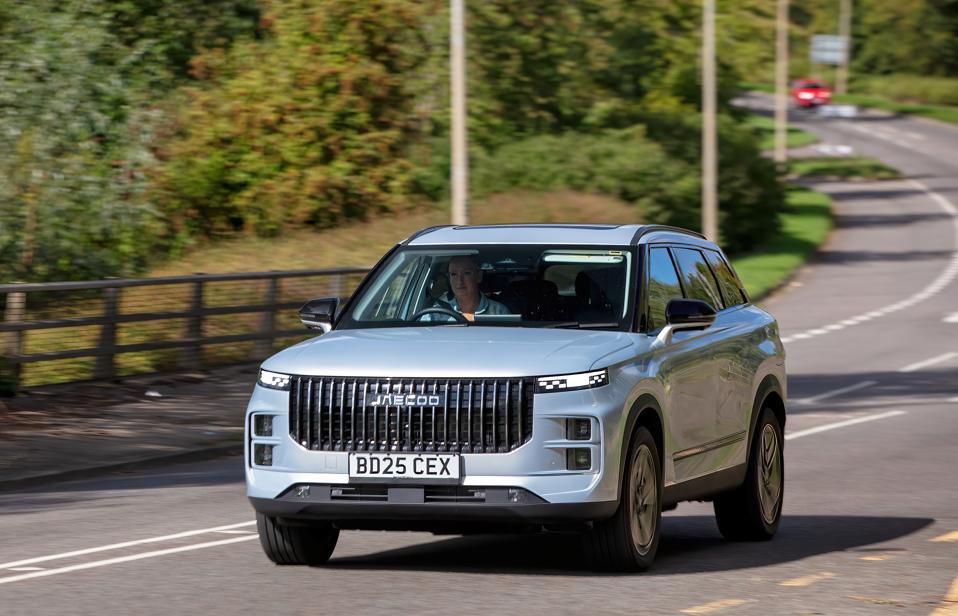The fact Chinese auto brands are accelerating sales in Europe won’t surprise anyone, but a report suggests their advantage is even bigger than conventional wisdom assumed.
According to Schmidt Automotive Research, Chinese auto sales, led by BYD, SAIC’s MG, and Chery’s Jaecoo, Omoda and Ebro brands, in September won 8% of Western European sales, edging out Korea’s 7.8%. In the electric vehicle market, China’s success was even stronger, with a 12.8% share, including more than 50 brands.
In the first nine months of the year, Chinese brands won a 10.7% share of Western Europe’s EV sales, beating Korea’s 8.5% and Japan’s 2.8%. U.S. sales, mainly Tesla, were at 13.6%, according to Schmidt Automotive.
China’s advantage, particularly with EV sales, was said to be about 30% in terms of costs, with a gap with the Europeans likely to take about 3 years to eliminate. That understates the case, says a report from investment researcher Bernstein.
“Chinese (manufacturers) are perceived to be 5 years ahead of Western peers in EV technology,” said Bernstein, quoting a survey of industrial leaders.
Responders to the survey of industry executives showed large majorities reckoned telling factors were Chinese leadership in battery technology, government support, market and corporate competition, and greater agility because there was no fear of undermining the traditional investment in internal combustion engines. This contrasts with Europe’s hesitancy to embrace EVs, knowing it will undermine their own highly profitable ICE vehicles.
“The competitive gap may be wider than perceived. To catch up, experts we surveyed believe Western (manufacturers) must prioritize cost reduction and organizational restructuring,” Bernstein said.
China’s battery leadership, government support
“China has largely mastered EV powertrains and is advancing in AI-enabled cockpits and Level 3+ autonomy, while international (manufacturers) remain focused on battery improvements. The critical question may no longer be how much market share can be reclaimed in China, but how to defend home turf as Chinese (manufacturers) intensify their global expansion,” Bernstein said.
French automotive consultancy Inovev said the upward trend in Chinese car sales, which has been steadily increasing since the beginning of 2025, and will continue in the coming months.
“This is largely due to the increased availability of these types of cars in Europe, the improved acceptance of Chinese products by European consumers, the ramp up of production of the Chery plant in Spain and the future opening of the BYD (factory) in Hungary (and Turkey),” Inovev said in a report.
“At this rate, Chinese cars (ICE and EV) could reach 7.5% of the European market or even 10% quite quickly,” Inovev said.
China even threatens Europe’s swanky cars
The threat from China isn’t limited to the mass market, Reuters Breaking Views column said.
“Swanky cars will be the next front for Chinese carmakers’ push into Europe. Despite the European Commission imposing tariffs of as much as 45% on battery-electric vehicles last year, Chinese automakers have nearly doubled sales in (Europe) so far in 2025. Now BYD and compatriots will take aim at the premium segment. Fresh tech and competitive pricing means they can vie with BMW, Porsche and peers on their home turf,” said BreakingViews columnist Katrina Hamlin.
Hamlin points out that this sales push into Europe isn‘t just the traditional progression of a nation becoming more competitive. It is also backed by the almost existential need to sell abroad because of chronic overcapacity at home. Overcapacity in China means the industry can make twice as many sedans and SUVs than the Chinese can buy, leading to price weakness. Exports can offer fatter margins with manufacturers able to raise prices to double or even treble the level of the home market, according to Hamlin.
Schmidt Automotive said the tariffs on EVs forced the Chinese to concentrate on hybrids, plug-in hybrids and ICE models
“While the incumbent players have been looking over their shoulders for an impending charge from Chinese BEVs, it’s been a multi-fuel advance that appears to be winning the day, driven partly by the EU’s anti-subsidy tariffs impacting BEVs only,” said founder Matt Schmidt.
“Ironically, just as Western (manufacturers) are getting their cost bases into line as they try to cover margin-dilutive BEVs as volumes increase to meet compliance targets, have they neglected to look in their multi-fuel rearview mirror?” Schmidt said.
No shortage of advice
The respondents to the Bernstein survey weren’t short of advice to help Western manufacturers face down the Chinese.
“To close the EV technology gap, respondents emphasize they must prioritize aggressive cost reduction and organizational restructuring. This includes supply chain integration, radical complexity reduction in platforms and variants, productivity improvements, and shifting R&D and production to China to leverage cost advantages and accelerate development cycles.”
“Investment in battery technology remains critical, as well as development of software and software-defined vehicle architectures. The respondents believe they could accelerate innovation in software by partnering with local Chinese companies and startups in batteries, semiconductors, AI, and software.”
Unfortunately, the respondents weren’t asked if they thought Western manufacturers might meet the challenge.

